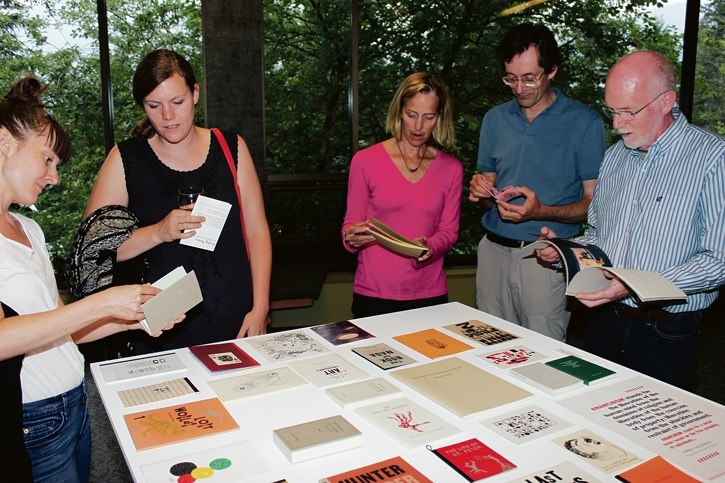What is art? Even artists themselves have to continually ask the question in and during a perpetual motion of thought and conjecture that eventually flows towards the finality of development.
What better way to show an artists work and existence than with a physical capsule that can encase the artists’ ideas, process and demands and also capture a stretch of a certain period of time than through book form?
Verlag Notes is an exhibition of artists’ books that offers an eclectic variety of works varying in esthetic and substance as much as the individual artists responsible for the artifacts.
The Banff Centre’s Peta Rake and Suzanne Rackover took it upon themselves to exhibit a handful of artists’ books the Walter Phillips Gallery and Paul D. Fleck Gallery have acquired over the last 40 years, last week.
Verlag Notes showcases two artists’ book publishers from The Banff Centre’s collection, Rainer Verlag (Berlin) and Perro Verlag (B.C.), and is a nod to an exhibition that took place at the Walter Phillips Gallery in 1985, titled Berlin Notes. It featured important artists in Berlin during the 1980s and involved 50 artists’ books from the German publishing house Rainer Verlag displayed for the public on a table within the exhibition.
Rake and Rackover pointed out that in the 1990 essay Artists’ Books by art writer and critic Nancy Tousley, the artist’s book has been marked by a “mercurial condition.”
“Given the resurgence of the production of artists’ books and multiples by a younger generation of artists, Tousley’s description of the format as continuing to shift, and refusing a staticness is especially prescient, reflecting this renewed interest in the approachable tactility of the artist’s book and the utopian gesture of the artist’s multiple that it draws on,” Rake and Rackover wrote.
“In presenting the vastly different artists’ books of the presses Rainer Verlag and Perro Verlag, Verlag Notes points to the surprising endurance of the mercurial condition.”
“We were talking about it before the show and someone pointed out the word resurgence in our text and she said, ‘Really, resurgence? Weren’t they always making it?” Rackover said.
“I think the distribution channels with the Internet as well as the facility of how easy it is to print in this day has made more artists open to the idea of putting artist’s books into their practice --– so I would say there probably is a resurgence.
“Artists that might have never thought of an artists’ books as an important element in their practice can all of a sudden realize, ‘I can print a book fairly easily that can be conceptually interesting and bring across my ideas and just go for it.’ ”
Artists continue to realize the need for a whole printing press or letterpress is a thing of the past, with a “do it yourself” (DYI) ethos back in vogue in the digital age,” said Rackover.
“DIY is a big thing again now, although I wouldn’t want to minimize the importance of creating an artist book as a work of art and not just as any old thing. The Perro Verlag works are letter pressed; unfortunately, you can’t see the interiors of all of them, but they are beautifully printed with the colour being very rich – definitely not a DIY press.”
“I think the most important thing for me was finding the connection between Perro Verlag and Rainer Verlag,” Rake said on the exhibition. “Perro is in B.C. and Rainer is obviously in Berlin, and for me finding that connection after interviewing Jo (Cook) and her saying that Rainer Verlag was such an influence on even starting a press, I think, is super important and in the end such a nice historical art connection between the two of them that kind of came out of nowhere.”
“The public is always welcome at our library and the artists’ book collection is a closed stacks collection, which means you can’t just browse it, but if they come in and ask to see the works, we’re happy to pull them,” Rackover said. “If they want items on specific ideas they can contact us in advance through our website and we’ll pull the work in advance for them – it’s important for us to let the public know we have this collection and anyone is welcome.”
After a chance meeting between Rainer Pretzell, the founder and namesake of Rainer Verlag, and Walter Phillips Gallery curator Lorne Falk, 50 Rainer Verlag artists’ books were packed in Falk’s suitcase and brought to Banff and were donated to The Banff Centre Library – the beginning of a rich collection of artists’ books which has now expanded to over 4,000 pieces.
Verlag Notes: an exhibition of artists’ books, runs at The Banff Centre’s Eric Harvie Theatre, West Lobby until Dec. 7.




